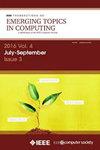A Novel Porcelain Fingerprinting Technique
IF 5.4
2区 计算机科学
Q1 COMPUTER SCIENCE, INFORMATION SYSTEMS
IEEE Transactions on Emerging Topics in Computing
Pub Date : 2025-03-17
DOI:10.1109/TETC.2025.3546602
引用次数: 0
Abstract
Porcelain, as a significant cultural heritage, embodies the wisdom of human civilization. However, existing anti-counterfeiting and authentication technologies for porcelain are often unreliable and costly. This paper proposes a physical unclonable functions (PUF) design based on crack physical feature extraction for the anti-counterfeiting and authentication of Gold-Wire porcelain. The proposed method generates PUF information by extracting inherent physical deviations in the surface cracks of Gold-Wire porcelain. First, a standard crack extraction process is established using digital image processing to obtain crack information from the porcelain surface. Then, a physical feature extraction model based on the chain code encoding technique and the Delaunay triangulation technique is used to derive the physical feature values from the cracks. Subsequently, a PUF encoding algorithm is designed to convert these physical feature values into a PUF response. Finally, the security and reliability of the designed PUF are evaluated, and a PUF-based porcelain authentication protocol is developed. Experimental results show that the proposed PUF exhibits 50.16% uniqueness and 98.85% reliability, and the PUF data successfully passed the NIST randomness test, demonstrating that the proposed technology can effectively achieve low-cost, high-reliability anti-counterfeiting for commercial porcelain.一种新的陶瓷指纹识别技术
瓷器作为一项重要的文化遗产,凝聚着人类文明的智慧。然而,现有的瓷器防伪和鉴定技术往往是不可靠和昂贵的。提出了一种基于裂纹物理特征提取的金丝瓷防伪认证物理不可克隆功能(PUF)设计。该方法通过提取金丝瓷表面裂纹中固有的物理偏差来生成PUF信息。首先,利用数字图像处理技术建立裂纹提取标准流程,获取裂纹信息;然后,采用基于链码编码技术和Delaunay三角剖分技术的物理特征提取模型,从裂缝中提取物理特征值;然后设计PUF编码算法,将这些物理特征值转换为PUF响应。最后,对所设计的PUF的安全性和可靠性进行了评估,并开发了基于PUF的瓷认证协议。实验结果表明,所提出的PUF具有50.16%的唯一性和98.85%的可靠性,并且PUF数据成功通过了NIST的随机性测试,表明所提出的技术可以有效地实现商品瓷器的低成本、高可靠性防伪。
本文章由计算机程序翻译,如有差异,请以英文原文为准。
求助全文
约1分钟内获得全文
求助全文
来源期刊

IEEE Transactions on Emerging Topics in Computing
Computer Science-Computer Science (miscellaneous)
CiteScore
12.10
自引率
5.10%
发文量
113
期刊介绍:
IEEE Transactions on Emerging Topics in Computing publishes papers on emerging aspects of computer science, computing technology, and computing applications not currently covered by other IEEE Computer Society Transactions. Some examples of emerging topics in computing include: IT for Green, Synthetic and organic computing structures and systems, Advanced analytics, Social/occupational computing, Location-based/client computer systems, Morphic computer design, Electronic game systems, & Health-care IT.
 求助内容:
求助内容: 应助结果提醒方式:
应助结果提醒方式:


